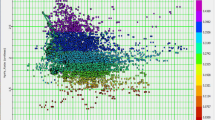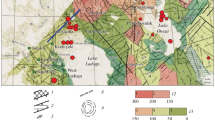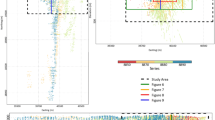Abstract
In the Buffalo Head Hills area a weights of evidence statistical approach was used to determine the spatial relationship of NNE-, NE-, NW-, and ENE-trending lineaments to known kimberlite locations. This method outlined different degrees of spatial correlation between and lineaments, with higher correlations defined for the NNE, NE, and ENE lineament data sets. A weights of evidence model then was constructed using the structural lineament maps, the Buffalo High and Buffalo Utikuma terrane boundary, Bouguer gravity data, and magnetic characteristics of the Buffalo High and Buffalo Utikuma terranes. The model reveals maximum favorability for kimberlite exploration along the Buffalo High and Utikuma terrane boundary in correspondence with NNE-trending lineaments and their intersections with NE and ENE lineaments. The relationship of the kimberlite occurrences along the Buffalo High-Buffalo Utikuma terrane boundary and structural lineaments seems to favor an hypothesis of kimberlite emplacement through a major zone of weakness in the basement, here characterized by the boundary between the Buffalo High and Buffalo Utikumaterranes.
Similar content being viewed by others
REFERENCES
Agterberg, F. P., 1989, Systematic approach to dealing with uncertainty of geoscience information in mineral exploration: Proc. 21st Symp. Application of Computers in the Mineral Industries (Las Vegas), p. 165-178.
Agterberg, F. P., Bonham-Carter, G. F., and Wright, D. F., 1990, Statistical pattern integration for mineral exploration, in Gaál, G., and Merriam, D. F., eds., Computer Applications in Resource Estimation Prediction and Assessment for Metals and Petroleum: Pergamon Press, Oxford, p. 1-21.
Bonham-Carter, G. F., 1994, Geographic Information Systems for geoscientists: modeling with GIS: Pergamon Press, Oxford, 398 p.
Bonham-Carter, G. F., Agterberg, F. P., and Wright, D. F., 1988, Interpretation of geological datasets for gold exploration inNova Scotia: Photogrammetr. Eng. Remote Sensing v. 54, no. 11, p. 1585-1592.
Bonham-Carter, G. F., Agterberg, F. P., and Wright, D. F., 1989, Weights of evidence modeling: a new approach to mapping mineral potential, in Agterberg F. P., and Bonham-Carter G. F., eds., Statistical Applications in Earth Sciences: Geol. Survey Canada Paper 89-9, p. 171-183.
Cant, D. J., 1988, Regional structure and development of the Peace River Arch, Alberta: a Paleozoic failed-rift system?: Can. Pet. Geology Bull., v. 36, no. 3, p. 284-295.
Carlson, S. M., Hillier,H.D., Hood, C. T., Pryde, R. P., and Skelton, D.N., 1998, The Buffalo Head Hills kimberlite province, north central Alberta, Canada: Seventh Intern. Kimberlite Conf. Extended Abstracts (Cape Town), p. 138-140.
Carlson, J. A., Kirkley, M. B., Thomas, E. M., and Hillier, W. D., 1999, Recent Canadian kimberlite discoveries: Seventh Intern. Kimberlite Conference, v. 1, p. 81-89.
Dredge, L. A., Kjarsgaard, I. M., Ward, B. C., Kerr, D. E., and Stirling, J.A. R., 1995, Distribution and chemistry of kimberlite indicator minerals, Aylmer Lake map area (76C), Northwest Territories: Geol. Survey Canada, Open File 3080, 160 p.
Eccles, D. R., Grunsky, E. C., Grobe, M., andWeiss, J., 2000, Structural emplacement model for kimberlitic diatremes in northern Alberta: Alberta Energy and Utilities Board and Alberta Geol. Survey, Rept. 116 p.
Edwards, D. J., Lyatsky, H. V., and Brown, R. J., 1995, Basement fault control on Phanerozoic stratigraphy in theWestern Canada Sedimentary Province: integration of potential-field and lithostratigraphic data, in Ross, G. M., eds., Alberta Basement Transects Workshop, Lithoprobe Rept. 47, p. 181-224.
Heaman, L. M., Kjarsgaard, I. M., and Craser, R. A., in press, The timing of kimberlite magmatism and implications for diamond exploration: a global perspective: Lithos.
Kemp, L. D., Bonham-Carter, G. F., and Raines, G. L., 1999, Arc-WofE: Arcview extension for weights of evidence mapping. http://ntserv.gis.nrcan.gc.ca/wofe (October 2001).
Leckie, D. A., Kjarsgaard, B. A., Pierce, J.W., Grist, A. M., Collins, A., Sweet, A., Stasiuk, L., Tomica, M. A., Eccles, R., Dufresne, M., Fenton, M. M., Pawlowicz, J. G., Blazer, S. A., McIntyre, D., and McNeil D., 1997, Geology of Late Cretaceous possible kimberlite at Mountain Lake, Alberta-chemistry, petrology, indicator minerals, aeromagnetic signature, age, stratigraphic position and setting: Geol. Survey Canada, Open File 3441, 202 p.
Mitchell, R. H., 1986, Kimberlites: Plenum Press, New York, 442 p.
Mitchell, R. H., 1995, Kimberlites, oragenites and related rocks: Plenum Press, New York, 410 p.
O'Connell, S. C., Dix, G. R., and Barclay, J. E., 1990, The origin, history and regional structural development of the Peace River Arch, Western Canada: Can. Pet. Geology Bull., v. 38A, p. 4-24.
Paganelli, F., Grunsky, E. C., and Richards, J. P., 2001, Structural interpretation of RADARSAT-1 principal component imagery and its potential application to kimberlite exploration in the Buffalo Head Hills area, northern central Alberta: Alberta Geol. Survey and Alberta Energy and Utilities Board, Earth Science Rept. 2001-03, 47 p.
Paganelli, F., Grunsky, E. C., and Richards, J. P., 2002, Use of RADARSAT-1 principal component imagery for structural mapping: a case study in the Buffalo Head Hills area, northern central Alberta, Canada: Intern. Jour. Remote Sensing, submitted.
Pilkington, M., Miles, W. F., Ross, G. M., and Roest, W. R., 2000, Potential-field signatures of buried Precambrian basement in theWestern Canada Sedimentary Basin: Can. Jour. Earth Sci., v. 37, no. 11, p. 1453-1471.
Ross, G. M., 1990, Deep crust and basement structure of the Peace River Arch: Constraints on mechanism of formation: Can. Pet. Geology Bull., v. 38A, p. 25-35.
Sarma, B. S. P., and Verna, B. K., 2001, Aeromagnetic lineaments, basement structure and kimberlite emplacement in Andhra Pradesh, India: Geophys. Res. Lett., v. 28, no. 22, p. 4307-4310.
Skelton,D., and Bursey, T., 1998, Assessment report, Buffalo Head Hills Property (ALO1), Ashton Mining of Canada Inc: Alberta Geol. Survey, Open-File 19980015, 16 p.
Smith, F. G., 1966, Geological data processing: Harper and Row, New York, 284 p.
Sobolev, N. V., Lavrentiev, Yu. G., Pokhilenko, N. P., and Usovo L. V., 1973, Chrome-rich garnets from the kimberlite of Yakutia and their paragenesis: Contribut. Mineral. Petrol., vol. 40, no. 1, p. 39-52.
Spiegelhalter, D. J., 1986, Uncertainty in expert systems, in Gale, W. A., ed., Artificial Intelligence and Statistics: Addison-Wesley Reading, Massachusetts, p. 17-55.
Tangestani, M. H., and Moore, F., 2001, Porphyry copper potential mapping using the weights of evidence model in a GIS, northern Shahr-e-Babak, Iran: Austr. Jour. Earth Sci., v. 48, no. 22, p. 695-701.
Ward, B. C., Kjarsgaard, I. M., Dredge, L. A., Kerr, D. E., and Stirling, J. A. R., 1995, Distribution and chemistry of kimberlite indicator minerals, Lac de Gras map area (76D), in Northwest Territories: Geol. Survey Canada, Open File 3079, 161 p.
Watson, G. P., Rencz, A. N., and Bonham-Carter, G. F., 1989, Computers assist prospecting: Geostation: Operat. Environm. Satell. (GOES), v. 18, no. 1, p. 8-15.
Wright, D. F., and Bonham-Carter, G. F., 1996, VHMS favourability mapping with GIS-based integration models, Chisel Lake-Anderson Lake area, in Bonham-Carter G. F., Galley A. G., and Hall, G. E., eds.,A Multidisciplinary Approach to Massive Sulfide Research in the Rusty Lake-Snow Lake Greenstone Belts, Manitoba: Geol. Survey Canada Bull. v. 426, p. 339-376.
Woodzick, T. L., and Mc Callum, M. E., 1982, A teledetective study of kimberlite regions in North America (Colorado-Wyoming), East Africa (Mwadui) and Siberia (MIR), in Kornprobst, J., ed., Third Intern. Kimberlite Conf., v. 1, p. 5-19.
Author information
Authors and Affiliations
Rights and permissions
About this article
Cite this article
Paganelli, F., Richards, J.P. & Grunsky, E.C. Integration of Structural, Gravity, and Magnetic Data Using the Weights of Evidence Method as a Tool for Kimberlite Exploration in the Buffalo Head Hills, Northern Central Alberta, Canada. Natural Resources Research 11, 219–236 (2002). https://doi.org/10.1023/A:1019936006314
Issue Date:
DOI: https://doi.org/10.1023/A:1019936006314




